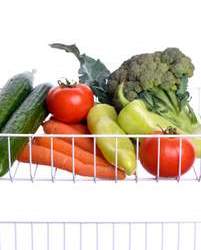|
How to Keep Vegetables FreshYour Guide to Storing Vegetables

Keep your produce fresher for longer with these tips on how to keep vegetables fresh. The goal of keeping fruit and vegetables fresh is to preserve vitamins, flavour and crispness. The condition of vegetables and most fruits begins to deteriorate as soon as they’re picked. Lack of freshness results in:
The best food storage methods slow deterioration and preserve freshness. Keeping fruit and vegetables fresh as long as possible ensures that when you eat them they are of the best quality possible. To get the best value for money and the highest nutrition, check the following guide on storing vegetables and fruit. Store high quality produceStore only high quality produce. The potential storage life of fruit and vegetables is affected by any damage they’ve sustained during harvesting and transporting. Bruises and damage leave produce more susceptible to rot. Handle even harder vegetables gently, as although bruises may not be visible produce can still sustain damage. Control temperatureStore produce at lower temperatures. This is the most effective way to slow the ageing process of fruit and vegetables. As a general rule, the more mature the fruit or vegetable the better its shelf life. Slow growing vegetables such as marrow and pumpkin keep longer, whereas fast-growing plants like broccoli, mushrooms and salad greens rot faster. Prevent dehydrationThe water content of fruits and vegetables is high, so even small percentages of moisture loss can result in limp and unappealing produce. Minimise damageProduce should be inspected regularly for rot or pests, and affected fruits and vegetables removed before the damage spreads. Fresh vegetable storage space should be cool, dry and free of pests. Sometimes your vegetable gardening is so successful that you are faced with the question of how to keep vegetables fresh when you have a ridiculous glut of produce. This often happens with tomatoes! When you can't possibly keep all your produce fresh long enough to eat it, other options for preserving fruit and vegetables include
dehydration
and
canning.
Tomkins, B. (1995). Agriculture Notes: Storage Life of Vegetables [online]. Knoxfield: Victorian Department of Primary Industries. Woolworths Ltd (1993). Fresh Food Cooking: The Healthy Way with Vegetables and Fruit. Epping, N.S.W. : R & R Publishing.
|
Are you as healthy as you can be?
Take action to lift your energy and vitality levels beyond recognition.
Focus on
building healthy eating habits for just one month with
Veg Up and you’ll enjoy the effects for years. You will amaze yourself when you see how much more you can achieve.
More Growing Raw
Newsletter
Be sure to subscribe to "More Growing Raw" newsletter to receive monthly healthy eating tips, Growing Raw news and updates.
Most Popular Articles
- Green Smoothie Health
- Raw Food Health Levels
- Growing Vegetables in Containers
- Healthy Eating Plans
- List of Healthy Food to Always Eat Organic
- Growing a Vegetable Garden in a Polytunnel
- All Natural Detox Diet
Does your body need a fresh start?
Brighten up with all natural detox routines that give your body a cleansing push towards healthier patterns.
Learn how to
detoxify your body naturally. Your body is smart enough to clean itself without expensive detox pills and potions.








